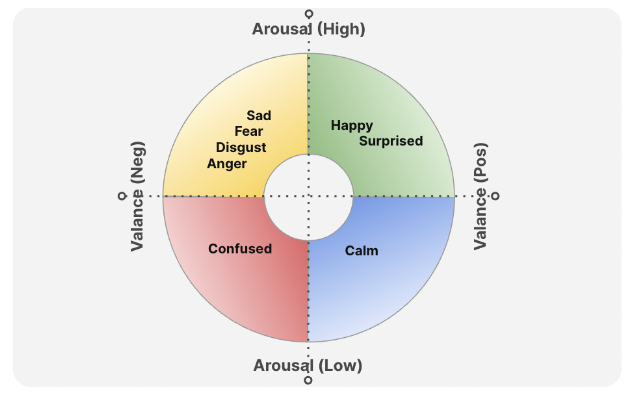Emotions in Advertising
Understanding emotional response and its impact on attention performance in media
Introducing emotions
Amplified employs industry-leading data collection methodologies to capture human attention data through camera-based systems across diverse platforms, formats, devices, and geographies.
After five years of collecting biometric attention from over 800 million human impressions, we are poised to enhance our core attention products with advanced emotions AI models, delivering even greater value to our customers. Amplified will now offer moment-by-moment attention in parallel with moment-by-moment emotion.
Why emotions?
We have advanced our AI capabilities by integrating moment-by-moment emotions into our stack, enabling us to accurately detect subtle changes in facial expressions over time, which are typically invisible to the naked eye.
Our system is now programmed to recognize the ‘classic’ eight emotions: confusion, disgust, anger, fear, sadness, calm, happiness, and surprise alongside the hundreds of impression attributes and active, passive and inattention gaze we already capture with attentionTRACE.
For transparency, we have chosen Amazon Rekognition AI for its unparalleled accuracy in face and facial expression recognition, which outperforms competitors like Microsoft and Face++. This decision is backed by the system’s extensive use of high-quality training datasets and its proven effectiveness in commercial applications, an approach we take seriously in our own established attention models.
This enhanced recognition model now operates in parallel with our three established proprietary attention models, enriching our ability to monitor how people feel and see on a second-by-second basis.
The dual capability of tracing emotional responses and tracking visual gaze in real-time, has a transformative impact on creative direction, content development, and strategic media planning.
What are emotional responses in advertising and what value do they provide?
Emotions have long played a vital role in advertising success, acting as catalysts for cognitive and behavioral responses, including content sharing, attentiveness, and sales. Before her groundbreaking research on attention, our Founder authored her first book on the relationship between emotional response patterns and the success of ad sharing. Even during a time when ‘cats on skateboards’ videos were the pinnacle of viral content, she gained recognition for her perceptive analysis of emotional data and its influence on media strategies.
“Understanding the interconnected roles of emotional content and media is crucial for brand and campaign success. These elements operate synergistically, not in isolation, each enhancing the impact of the other. However, grasping the nuances and interdependencies of how these factors interact is essential. By incorporating emotional analysis into our machine learning stack, we not only unlock the qualitative and quantitative benefits of creative content that brands value but also contextualise it within the dynamics of real-time attention and its interactive effects in media.” Dr Karen Nelson-Field
Emotions are defined by both arousal and valence (arousal is about the intensity of an emotional response, valence is about positive or negative tone). Grouping them this way has a long history in emotions research and heightens the value to brands given their direct and noted relationship to active and passive attention.
Low arousal states—both negative and positive valenced—are associated with broadened attention (passive attention) because there is a lower motivation to approach a goal or desire.
By contrast, high arousal states are associated with rather narrow cognitive processing (active attention) due to increased motivational intensity which leads to a focus on the desired goal or object. Understanding how all this connects maximises outcomes for campaign objectives.

Influence of emotional response in relation to audience’s attention
We know that emotions act as an amplifier of attention, but their ability to do so is mediated by the format. This means that the same creative content, even with an identical emotional profile, will generate varying levels of attention depending on the format’s attention limits.
This is why testing creative content without considering its media placement will reveal whether creative A or B is technically better, but it won’t accurately reflect their real-world market performance.
Without understanding their real-world market performance, resources spent on creating a highly emotional ad may be wasted.
We know that high-arousal positive emotions are most strongly related to active attention, a finding consistent with previous studies. When more attention is generated, there is a greater likelihood of memory formation.
We have run our entire back catalog of data through our emotions AI, enabling us to understand the emotional profile of all social media platforms, TV, and the open web.
The advantage of emotional response
“Emotions can be fleeting, with a quick onset, and an equally quick dissipation. The ability to passively track moment-by-moment responses (at .2 of a second) are an advantage over self-reported or other biometric techniques which can lack sensitivity to the dynamism of emotions, particularly when gaze based attention tracking in real-time media usage is not present to calibrate the results.”
Dr Karen Nelson-Field
How you can capture human emotion and attention with attentionTRACE
Understand how people are viewing your advertising via our leading human attention data capture tool, attentionTRACE.
Test your branded creative and messaging using real human attention in real environments.
attentionTRACE’s emotional response capability is available on attention measurement studies across a host of advertising channels including mobile social media, open web, audio streaming, cinema and outdoor advertising.
How others have tracked emotional response
A joint study between Amplified Intelligence and Pinterest in 2024 showed there is a distinct correlation between intense (high arousal) emotional reactions and amplified attention, which can maximise ad engagement — averaging at around 5% uplift. The study, which analysed data covering a panel of 2,400 users, six markets and over 59,574 total ad views, explored the close relationship between attention and emotion.